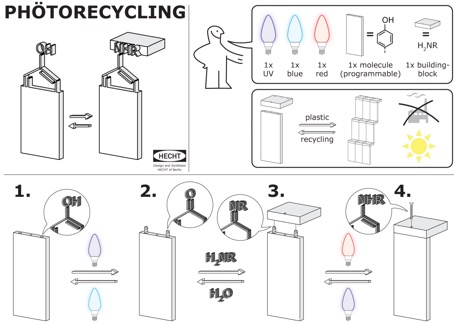Light-controlled molecules: Scientists develop new recycling strategy

A programmable molecule in combination with a specific light sequence allows for bond formation (UV and red light; 1. to 4.) or scission (UV and blue light; 4. to 1.) with molecular building-blocks. Visualization: Michael Kathan
Robust plastics are composed of molecular building-blocks, held together by tough chemical linkages. Their cleavage is extremely difficult to achieve, rendering the recycling of these materials almost impossible.
A research team from the Humboldt-Universität zu Berlin (HU) developed a molecule, which can drive or reverse specific chemical reactions with light of different colors. This enables making and breaking of connections on the molecular scale, even if they are exceptionally strong.
The discovery paves the way for the development of novel recycling methods and sustainable materials. Light-driven recovery of individual molecular building-blocks has great potential to enable recycling of yet non-recyclable plastics without compromising on color, quality, or shape.
“The working principle of our system is quite similar to the one of ready-to-assemble furniture” explain Michael Kathan and Fabian Eisenreich, the two first authors of this study. “We are able to repetitively assemble or disassemble molecular architectures, but instead of a hammer and screw-driver, we use red and blue LEDs as tools to control our molecules.”
The results of their study have just been published in Nature Chemistry.
Publication
“Light-driven molecular trap enables bidirectional manipulation of dynamic covalent systems” In: Nature Chemistry (2018), DOI: 10.1038/s41557-018-0106-8
Authors: Michael Kathan, Fabian Eisenreich, Christoph Jurissek, Andre Dallmann, Johannes Gurke, and Stefan Hecht
Prof. Stefan Hecht, Ph.D.
Department of Chemistry / IRIS Adlershof
Tel.: +49 30 2093-7365
sh@chemie.hu-berlin.de
Media Contact
More Information:
http://www.hu-berlin.de/All latest news from the category: Life Sciences and Chemistry
Articles and reports from the Life Sciences and chemistry area deal with applied and basic research into modern biology, chemistry and human medicine.
Valuable information can be found on a range of life sciences fields including bacteriology, biochemistry, bionics, bioinformatics, biophysics, biotechnology, genetics, geobotany, human biology, marine biology, microbiology, molecular biology, cellular biology, zoology, bioinorganic chemistry, microchemistry and environmental chemistry.
Newest articles

Sea slugs inspire highly stretchable biomedical sensor
USC Viterbi School of Engineering researcher Hangbo Zhao presents findings on highly stretchable and customizable microneedles for application in fields including neuroscience, tissue engineering, and wearable bioelectronics. The revolution in…

Twisting and binding matter waves with photons in a cavity
Precisely measuring the energy states of individual atoms has been a historical challenge for physicists due to atomic recoil. When an atom interacts with a photon, the atom “recoils” in…

Nanotubes, nanoparticles, and antibodies detect tiny amounts of fentanyl
New sensor is six orders of magnitude more sensitive than the next best thing. A research team at Pitt led by Alexander Star, a chemistry professor in the Kenneth P. Dietrich…





















